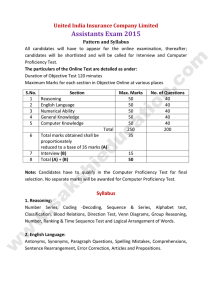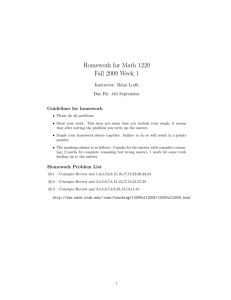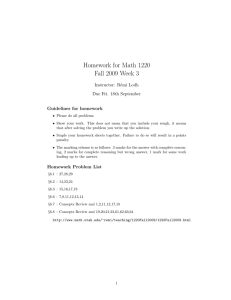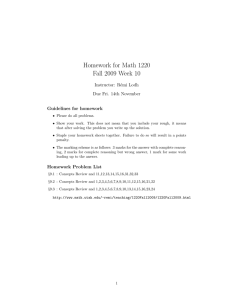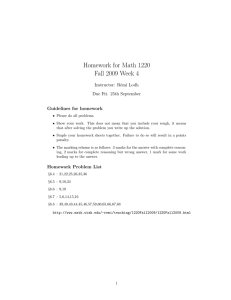9694 THINKING SKILLS MARK SCHEME for the May/June 2010 question paper
advertisement
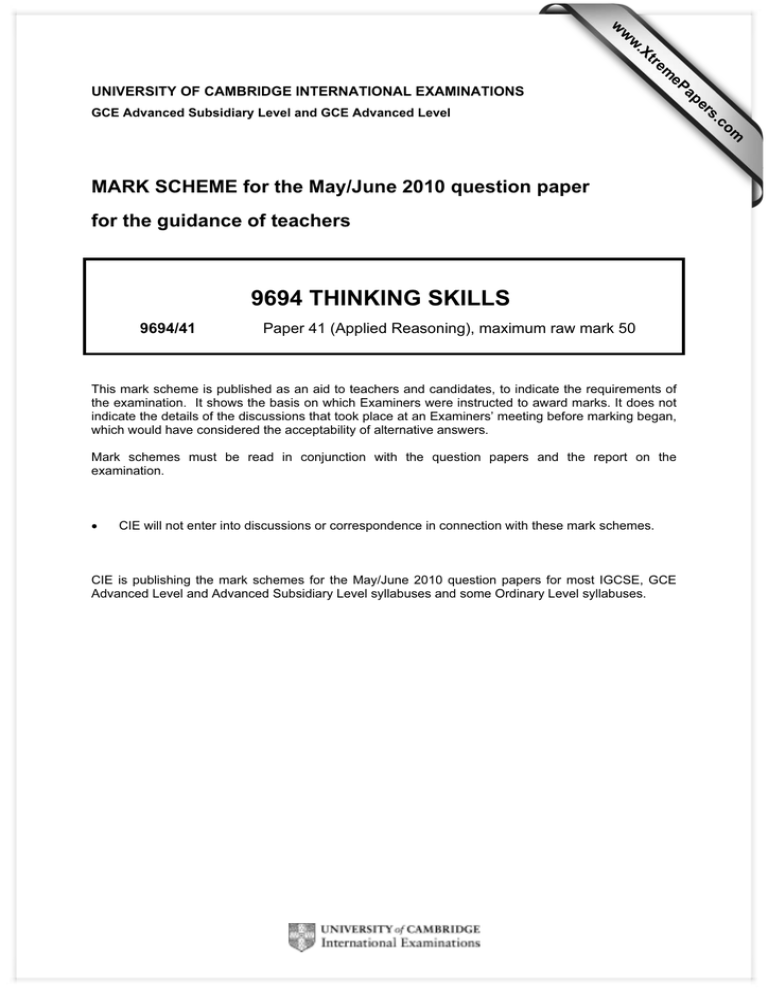
w w ap eP m e tr .X w UNIVERSITY OF CAMBRIDGE INTERNATIONAL EXAMINATIONS for the guidance of teachers 9694 THINKING SKILLS 9694/41 Paper 41 (Applied Reasoning), maximum raw mark 50 This mark scheme is published as an aid to teachers and candidates, to indicate the requirements of the examination. It shows the basis on which Examiners were instructed to award marks. It does not indicate the details of the discussions that took place at an Examiners’ meeting before marking began, which would have considered the acceptability of alternative answers. Mark schemes must be read in conjunction with the question papers and the report on the examination. • CIE will not enter into discussions or correspondence in connection with these mark schemes. CIE is publishing the mark schemes for the May/June 2010 question papers for most IGCSE, GCE Advanced Level and Advanced Subsidiary Level syllabuses and some Ordinary Level syllabuses. om .c MARK SCHEME for the May/June 2010 question paper s er GCE Advanced Subsidiary Level and GCE Advanced Level Page 2 1 Mark Scheme: Teachers’ version GCE AS/A LEVEL – May/June 2010 Syllabus 9694 Paper 41 (a) What is the greatest number of cakes that the stall organizer could make using any one person’s recipe? [2] 30 2 marks for the correct answer If 2 marks are not given, give one mark for ‘40’ [which would be a good answer if the candidate allowed one of the chefs to make no cakes] (b) If the stall organiser decides upon making the most cakes possible using William’s recipe, show that the total amount of unused ingredients is 450 g. [3] Making 30 of William’s, 15 of Mary’s and 15 of Chris’s cakes would require 1200 g of raisins, 1050 g of chocolate and 1350 g of ginger. If equal quantities were purchased, 1350 g would be needed. And therefore the amount wasted would be (1350 – 1200) + (1350 – 1050) = 150 + 300 = 450 g. Award marks cumulatively since this is a demonstration, and the final numerical answer is worth no marks. Award 1 mark for the correct calculation of at least one of the total quantities of ingredients needed [1200 g, 1050 g, 1350 g]. Award 2 marks for all three ingredients’ quantities calculated correctly. Award 3 marks for some working which shows how these total quantities lead to 450 g being wasted: this will involve either (1350 – 1200) + (1350 – 1050) or 150 + 300 or 4050 – 3600. If candidates choose the wrong combinations of cakes [i.e. not 30, 15, 15] credit 1 mark if they get the correct quantities for all the ingredients. (c) What is the least number of cakes that the stall organiser could make of any one of the recipes? [1] 12 1 mark for the correct answer © UCLES 2010 Page 3 Mark Scheme: Teachers’ version GCE AS/A LEVEL – May/June 2010 Syllabus 9694 Paper 41 (d) Show that it is possible to produce 60 cakes with less than 50 g of unused ingredients. [4] 14 of Mary’s, 25 of William’s and 21 of Chris’s. This will produce 20 g of wasted ingredients. 4 marks – for the number of cakes and the wasted quantities given above. If 4 marks cannot be awarded, 3 marks – for the following suboptimal answers, in which no more than 100 g is left over: Mary William Chris raisins choc ginger left over 13 26 21 1200 1230 1250 70 13 25 22 1210 1260 1230 80 14 26 20 1220 1200 1260 100 14 24 22 1240 1260 1220 60 15 25 20 1250 1200 1250 50 15 24 21 1260 1230 1230 60 15 23 22 1270 1260 1210 70 If 3 marks cannot be awarded, 2 marks – for attempting two combinations of cakes and calculating the wastage correctly. If 2 marks cannot be awarded, 1 mark – for attempting one correctly calculated combination [and wastage]. 2 (a) Heather Palm took the lead in the first event and remained ahead overall throughout the competition. (i) Name the events in which Heather Palm was the top scorer. 100m hurdles, high jump, 200m, long jump. If 2 marks cannot be awarded, award 1 mark for 2 or 3 correct events. Deduct 1 mark for each incorrect answer (minimum 0 marks). [2] award 2 marks (ii) Name an athlete who was top scorer in at least one of the other events. Daisy Rowan (shot put) or Ivy Birch (javelin and 800m). [1] award 1 mark (b) With a highest score of 938 points (100m Hurdles) and a lowest score of 629 points (Shot Put), Heather Palm’s scores had a range of 309 points. (i) Who had the largest range of scores? Iris Linden (406 points) [1] award 1 mark (ii) Who had the smallest range of scores? Lily Pine (200 points) [1] award 1 mark © UCLES 2010 Page 4 Mark Scheme: Teachers’ version GCE AS/A LEVEL – May/June 2010 Syllabus 9694 Paper 41 (c) This is part of the table used to convert performances to points in the High Jump: (i) Which athlete appealed? [1] Daisy Rowan award 1 mark (ii) What was her final overall position after the results had been corrected? [2] 3rd award 2 marks If 2 marks cannot be awarded, award 1 mark for evidence that her total score was amended to 4651 points (or was increased by 180 points). (d) Ivy Birch was disappointed not to be victorious. She blamed her failure on a Long Jump performance that fell considerably short of her personal best. Based on the evidence in the results summary, suggest the minimum distance in the Long Jump that would have enabled her to win the Heptathlon. [2] 5.38m – 5.43m award 2 marks The difference of 14 points between 5.49m and 5.44m, and also between 5.25m and 5.20m, suggests that 5.39m = 669 points (though in the official table 5.39m = 668 points). Ivy Birch would have needed 673 points to produce an overall total of 5396 points. If 2 marks cannot be awarded, award 1 mark for evidence that Ivy Birch needed to score 673 points OR award 1 mark for evidence that candidates find a points per cm ratio (in between 2.66 and 2.89) or cm per point (0.345 to 0.375) 3 (a) Analyse the structure of the argument in Document 1, identifying its main conclusion and reasons, as well as any intermediate conclusions and counter-arguments. [4] Main Conclusion: We should never enter into debates about what is free speech and what is hate speech. R1 – Freedom of speech and expression used to take priority over all freedoms. R2 – But many countries have given hate laws precedence over free speech. IC1– (Therefore), to deny free speech, on the grounds that certain speech makes people uncomfortable, is denying (some) people (one of) their basic human right. R4 – The UN charter states that you should have freedom of opinion and expression without interference. R5 – But (can it be right that) the laws of government trample all over the entitlement to free speech enshrined in UN charter for Human Rights. IC2 – (Therefore) Governments are actually seeking fascist control over people. R7 – When people write politically incorrect statements in countries that have forfeited the right to unabridged free speech they get accused of hate speech. R8 – Even the mildest statements are not tolerated (or equivalent or quote text). IC3 – (Therefore) It is very important to insist on unabridged freedom of expression. R10 – The real haters are the people who hate freedom... R11 – Tyrants fear free speech... R12 – Many people are in favour of free speech and freedom of expression. IC4 – (Therefore) When governments start to decide what is freedom of expression (or speech) ... in order to suit their own agenda (or equivalent) we should resist. © UCLES 2010 Page 5 Mark Scheme: Teachers’ version GCE AS/A LEVEL – May/June 2010 Syllabus 9694 Paper 41 IC5 – (Therefore) By dictating what counts as ‘free speech’ and what counts as ‘hate speech’, (the) true (concept of) free speech is destroyed. IC1 + IC2 + IC3 + IC4 + IC5 → MC Counter Argument – Some people say that it is important to balance ‘freedom of expression’ with ‘freedom to live without hate’. Or Some people say that anyone who takes this viewpoint (of insisting on unabridged freedom of expression) is promoting hate. Marks: Gist or just MC = 1 mark. MC + 1 IC = 2 marks MC + 2 / 3 ICs = 3 marks MC + 4 / 5 or more IC’s = 4 marks Candidates who mistake the IC5 for MC: IC5 + 1 IC = 1 mark IC5 + 2 IC’s = 2 mark IC5 + 3 more ICs = 3marks Candidates who fail to identify MC (or IC5 as MC), but identify 3 or more ICs = 2 marks. (b) Read Documents 2 and 3. Evaluate the strength and/or weaknesses, and any underlying assumptions, in Lee’s and Tan’s reasoning in Document 3. You do not need to compare Lee’s and Tan’s arguments, but you do need to evaluate each person’s argument as a response to the question posed to them. [6] Marks: Each person’s argument has to be evaluated as a response to the question ‘Should free speech include hate speeches?’. There are basically 3 main weaknesses in each person’s argument. These focus on: 1. Causal link between acts of speech and physical acts. The candidate may express this in a variety of ways – if they have correctly identified the causal link they should be able to get the mark. 2. The slippery slope fallacy. 3. Pinpointing the inconsistency in Milton’s argument. © UCLES 2010 Page 6 Mark Scheme: Teachers’ version GCE AS/A LEVEL – May/June 2010 Syllabus 9694 Paper 41 Lee’s argument: 1. Weakness: Hate speech may influence people towards biased viewpoints but to state that they cause acts of hatred is too strong unless it can be proved beyond reasonable doubt. Applying the Harm Principle (Doc 2), means one would have to prove that harm/ violation of rights was caused by pornographic expressions or speeches by extreme groups. 2. Weakness: Lee commits the slippery slope fallacy by insisting that if we allow the expression of hate speeches, we will end up forfeiting democracy, a large claim to make considering that democracy allows for expression of opposing views. Lee does not make a case for protecting the liberty to free speech (by arguing for some safeguarding limits) but rather restraining all ‘hate speeches’. 3. Weakness: Selectivity – examples of Ku Klux Klan, IRA, Taliban (credit if candidates phrase their answer to demonstrate these have been selected to support a certain viewpoint). 4. Weakness: Lee can only justify Milton’s inconsistency on the assumption that ideals cannot be realized in real life, whereas human aspirations demand an ideal for a goal and nor can all ideals be been shown to be unachievable in human experience. For each sound evaluative point 1 mark, or 2 for a developed point, up to maximum of 4 marks. Tan’s argument 1. Strength: Tan rightly says that there is no necessary link/correlation between speech acts and physical acts. It would be very difficult to establish the causal link between the mere hearing and the acting. The Harm principle in Doc 2 would require proving that whatever was said caused harm or violation of rights to others in order to justify a prohibitive sanction. (If candidates identify the right area in Tan’s argument they should get a mark. If they explain it further they will get 2 marks). 2. Weakness: Tan too rushes down the slippery slope by stating that any attempt to regulate free speech will lead to state tyranny and censorship of any opposition to government, whereas it could be argued that it would be possible to exercise some measure of limits and censorship in extreme cases of hate speech, in the interests of protecting liberty of civil existence. 3. Weakness: In defending Milton against the inconsistency charge, Tan contradicts his own principle – i.e. that allowing bad views to be voiced increases the likelihood of defeating them. One could argue that allowing Roman Catholics to voice dissidence would lead to their courting defeat. Further he seems to be justifying the silencing of minority views and repressing them – which goes against the democratic principle the free speech concept vouches for. Candidates may identify/describe Tan’s flaw in reasoning in a variety of ways and these should be credited if they explain the contradiction or inconsistency in his position. 4. Weakness: His reasoning that truth combats error also rests on the assumption that the Roman Catholic’s political position is necessarily ‘error’. For each sound evaluative point 1 mark, or 2 for a developed point, up to maximum of 4 marks. [Max 6] Maximum overall for 3 (b) – 6 marks. © UCLES 2010 Page 7 Mark Scheme: Teachers’ version GCE AS/A LEVEL – May/June 2010 Syllabus 9694 Paper 41 (c) Construct your own well-reasoned case arguing for whether you would or would not accept limits to free speech. Your response should: • • • refer to Article 19 of the Universal Declaration of Human Rights in Document 4. critically comment on some or all of Documents 1–5. have a clear conclusion. [20] (Candidates are expected (anticipated) to apply critical reasoning to a regional context, most likely to the country of residence, in arguing for a policy on free speech.) Credit will be given for the judicious use of resources in the documents. Candidates should be able to select relevant materials and significant data from the documents that both support and counter their own argument. Whichever position the candidate takes, a creditworthy response should reference some of the material in Document 2, as it has key relevance for any argument on free speech. No argument for/against limits on free speech is possible without reference to the problem inherent in the concept of free speech itself – and for this the candidate would have to necessarily select material from Document 4 as well, as the question specifically requires reference to Article 19. Data from document 5 can also be utilized for reasoning one’s case. Credit will be given for the assessment and interpretation of evidence and inferences candidates draw from critiquing the sources. Candidates should be able to synthesise information and compare and contrast opinions from different sources. Complete freedom of speech advocated in Document 1 can be set against the existential situations arising in Documents 2 and 5. Document 5 may be interpreted for a correlation between political rights and civil liberties. Very astute candidates may point out that free speech is captive to political realities on the ground since the downward and upward trend arrows show a twoway migration is possible. Countries which may have opted for political freedom can witness a slide towards a lesser civil liberties freedom, and countries with less political freedom may progress upwards in regard to civil liberties. The inference could be drawn that countries have differing human rights situations according to their cultural matrix. Candidates may construct a reasoned case by focusing on different aspects of the problem of Free Speech, and should be credited as long as they have a relevant debate. The scope of the question can allow for responses to extend to how to implement a policy of free speech, given the problems, or whether to implement such a policy, given the problems; or whether generally restrictions can/cannot be or should/should not be imposed on Free Speech. Candidates may approach the question in various ways. For example, they may orbit all the other documents around Document 2, which has a central position in the debate, and come to a reasoned judgment. Or they may examine the concept of free speech, discuss the ambiguities of Article 19, the difficulties of implementing Free Speech in their own country’s society and propose a middle way. © UCLES 2010 Page 8 Mark Scheme: Teachers’ version GCE AS/A LEVEL – May/June 2010 Syllabus 9694 Paper 41 Credit will be given for other examples, further arguments and observations candidates incorporate to build a cogent and coherent case. Candidates may refer to the unrestricted nature of online speech and the effects. Anecdotal reasoning and focus on specific isolated cases to argue for or against implementing free speech can be credited only insofar as they are within the context of the problem of free speech as a concept, as highlighted by Documents 2 and 4. Responses that deviate into a rant against the dangers of free speeches or hate speeches without any reference to the complexities, given that the question insists on a reference to Article 19 in Document 4, will be relegated to the lower credit bands. Responses that conflate free speech with general human rights, and thus wander away from the question of Free Speech may be relegated to lower mark bands or viewed as stream of consciousness. Good to excellent answers will have explicitly posited and dealt with counter arguments to own reasoning. No marks will be reserved for the quality of written English. No additional marks will be given for bringing further understanding/knowledge of Milton or Mill, to supplement or annotate the material within Document 2, but credit will be awarded for any extra critical reasoning aimed at strengthening or weakening the target argument. Levels of Response bottom Middle Top Band Overall A critical stance: ideally an evaluation of sources, and explicit consideration of counter-arguments (or conflicting sources). Reference to at least 3 docs. A reasoned stance: a clear conclusion, supported by reasons clearly expressed/cherry-picked from the sources. Some independent reasoning. Reference to docs. “Pub rhetoric”: unclear conclusion, reasoning that goes off at a tangent (substantial irrelevant material). Within Candidates must introduce their own ideas and arguments. Occasional explicit critical comments. Implicit consideration of counterarguments/critical comments. Clear statement of 2/3 reasons in support. Reference to at least 2 docs. Reasons re-stated from sources. Some irrelevance/deviation from the question. May be multiple conclusions with little support for each one. Reproduced reasoning from (a) and (b). Disorganised. Stream of consciousness. © UCLES 2010 Score 20 19 18 17 16 15 14 13 12 11 10 09 08 07 06 05 04 03 02 01




